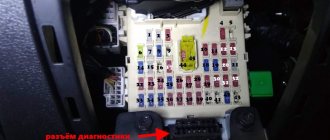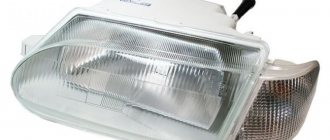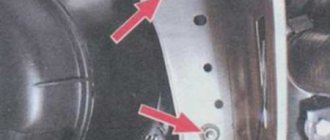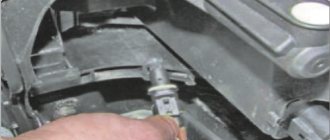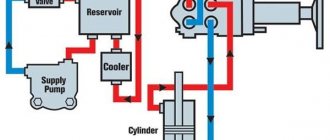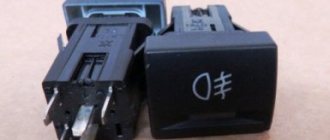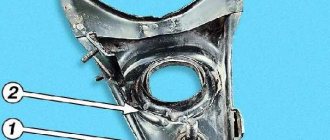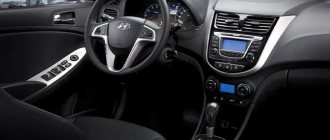Hyundai Solaris is a popular subcompact car produced by Hyundai Motors in the Russian Federation. The package was developed as an adaptive version of the Hyundai Accent for the Russian climate. Production was launched in 2010, and two generations of cars have been built in sedan and hatchback bodies.
The four-door sedan and five-door hatchback were produced in the Russian Federation until 2017 and each received two updates to the interior, power unit and body. For all assembly options, only one block headlights with halogen standard lamps were installed.
Dismantling and installation of headlights
Reinstallation of the optics unit is associated with tuning options, replacement of the ceiling or lamp. The headlight of the Hyundai Solaris is located at the corners of the car and is made in an elegant drop shape. The quality of standard lights meets the driver’s needs 100%; thanks to their favorable location, it is possible to effectively adjust the geometry of the light beam. The light is controlled by switching sensors on the dashboard.
Manual configuration remains an important advantage. The headlight can be adjusted to specific operating conditions depending on the changed ground clearance. As the ground clearance decreases, the angle of illumination of the road changes. Manual adjustment allows you to obtain optimal illumination of the road and roadside in any conditions. Removal and installation of the front headlight in the sedan configuration is carried out in stages:
- Disconnect the negative terminal from the battery.
- Remove the front bumper.
- Rotate the turn signal socket and remove it from the housing.
- Release the latch and disconnect the connector.
- The headlight mounting location will open - unscrew the four bolts with a 10mm wrench.
- Release the latch.
- Remove the headlight unit.
- Rotate the dirt boot.
- Disconnect the wire block, press the lock and remove the lamp.
After the work has been completed - tuning, replacing a burnt-out lamp, installing optics are carried out in the reverse order.
The shape of the headlight unit in the restyled version of the Hyundai sedan and in the hatchback configuration differs from the first generation, the principle of dismantling remains the same.
There are two ways to remove the rear light on a Solaris:
- Remove the trim if large-scale repairs are being made to the adjacent part of the body.
- Open the pocket in the casing, through which access to the optics is provided.
To remove the taillight you will need a 10mm wrench and good eyesight. Dismantling is carried out step by step.
- Disconnect power from the battery.
- Remove the power plug from the headlight unit.
- Use a wrench to unscrew the nuts.
- Slowly pull the headlight towards you against the installed studs.
- Remove the seat from the piston that presses the block to the wing.
After repair, replacement, tuning, reassemble in the reverse order.
How to disassemble a Solaris headlight
The Hyundai Solaris headlight is an electrical device, and therefore requires compliance with basic safety rules. Before you begin work on removing the Solaris headlight, do not forget to disconnect the battery. Disconnect the lamp unit connector by lightly pressing the latch (it is more convenient to do this with a small screwdriver). The headlight on the Solaris is attached to the body with several bolts; you need to unscrew them and carefully remove the headlight, having previously removed it from the technological grooves.
The dismantled Solaris headlight is transferred to the table and placed on a piece of soft cloth. It is more convenient to carry out further work on replacing lamps on a desktop. Remove the protective cover made of transparent material and take out the burnt out light bulb. Perform a similar procedure with the side lamps.
When dismantling is necessary
Disassembly of optics and reinstallation of lamps or ceiling lamps is carried out in the following cases:
- Damage to the headlight surface. Large cracks occur after being hit by a stone thrown at speed from under the wheels of oncoming traffic. The part is being replaced.
- Natural surface wear. Small cracks appear on the headlight, which reduce the luminous flux by 20 - 50%. The optics are being polished and restored.
- The light bulb has burned out. The low and high beam in the Hyundai Solaris is provided by a standard 55/60 Volt halogen lamp. The part is being replaced.
- Tuning. Reinstallation of the standard light to an analogue one - xenon or LED. It is necessary to remove the Solaris headlight and improve the design.
Video review of the procedure for replacing the low/high beam lamp of Hyundai Solaris from 2015
–>
Low efficiency of head optics is the curse of the Hyundai Solaris and Kia Rio, especially the first, pre-restyling cars. There were probably no owners who did not criticize the quality of the light of these cars. The problem is most clearly characterized by the fact that on the Solaris forum one of the most popular topics is the one with the title “Dipped beam – it doesn’t exist at all!!!” Please note that it is not the haters who denigrate the car, but the owners themselves who evaluate the quality of the optics.
Hyundai Solaris and Kia Rio 2011
Although the Solaris and Rio headlights differ in shape, they have the same problems and incorporate all possible “jambs”. Firstly, they have the simplest design with one diffuser and one light bulb for near and far. Secondly, the intricate shape, which is very different from the optimal circle for headlights. The design is nice, but at the expense of light quality. Thirdly, the design of the diffuser is poor. Headlights fit into formal standards, but they cannot provide high-quality lighting, especially in the rain.
Headlights of Kia Rio III and Hyundai Solaris
It has become easier for buyers of restyled cars, because the top trim levels now have optics with a lens that shines well, and during the latest update they even brought in LED optics. But there are several hundred thousand pre-restyling Hyundai Solaris and Kia Rios driving around the country, whose drivers feel very uncomfortable at night.
Kia Rio III restyling with lensed optics
Many people try to improve the light by installing xenon or H4 LED lamps, but this is illegal. A reflector headlight with such light sources cannot be adjusted normally, and problems with the traffic police are guaranteed. You can use more expensive and high-quality halogen lamps, but this does not give such a big increase, and the cost of the lamps is several times higher than usual.
And yet, car owners have found a way to slightly improve the light without violating traffic regulations and without much expense. The fact is that in the design of the headlights of the pre-restyling Hyundai Solaris and Kia Rio there is a special cap that covers the bulb. No one fully understood the meaning of its installation. Some people think that this is just a decorative element so that the lamp does not stick out. According to others, it somehow helps reduce flare. However, it is quite obvious that a capped bulb will produce less light than an uncapped one. There were test laboratories that conducted a similar experiment, checking the brightness with a lux meter - and indeed: the headlights begin to shine better if this cap is removed.
End cap in the headlight Hyundai Solaris 2011
Of course, the optics do not turn into spotlights and do not begin to compete with elite matrix headlights, but the increase in light is noticeable even to the eye. And if you also install light bulbs with increased light output (not to be confused with high-power bulbs, they will melt the headlight!), then you can drive more or less normally.
The top of the headlight is without a cap, the bottom is with a cap.
Only two questions remain: will a headlight without caps blind oncoming drivers, and how will this cap be eventually removed? The answer to the first one is simple – it won’t. This has been confirmed by several laboratory studies; the cap does not affect the cut-off line in any way; even without it, the headlights draw a clear “daw”, above which there is no glare. But regarding removal, there are two options.
Hyundai Solaris headlight from inside
The cap itself is attached to one self-tapping screw, which is unscrewed from the side of the headlight cover. So it’s easy to unscrew it, but it’s much more difficult to pull it out of the headlight, because it doesn’t fit into the hole for the light bulb. The best option is to remove the headlight and disassemble it. The design of the optics allows for this option, but this is a path for the hardworking - and dismantling the headlights and disassembling them requires some diligence. But the cap will remain intact and unharmed. If you really want, you can install it back.
Solaris headlight
The second option is more barbaric. Insert pliers through the hole for the lamp and flatten the cap directly inside the headlight so that it fits through the hole. After this, of course, you can only throw the cap away, but if you remove it anyway, then it’s not a big loss. The danger of this method is that you can inadvertently scratch or even break the headlight reflector. Then you'll have to buy a new one. Moreover, it is difficult to imagine that such an operation could be performed on a car. The headlight will still have to be removed, but there is no need to disassemble it.
End cap
Whether the result of removing the cap is worth the effort - each owner decides for himself. There is an effect, but you need to sensibly evaluate expectations, as xenon headlights will not shine anyway. But such an alteration does not blind oncoming people and does not lead to problems with the traffic police. In the end, even Korean engineers realized the harm of the cap and it is no longer available on restyled versions of cars.
By the way, on the forums you can find another way to improve the light, but it is rather dubious. You need to put some washers in the places where the headlight is attached in order to place it 2-3 millimeters closer to the reflector compared to the standard version. That is, as if to “not stick”. It is quite obvious that all calculations for designing a reflector in this position of the lamp cease to work, but the effect is unusual.
The low beam becomes noticeably denser and thicker, the illumination of the roadsides improves, while the cut-off line remains the same and the headlights do not blind oncoming traffic, but the high beam flies somewhere into the sky - the signs are illuminated perfectly, but almost no light reaches the wheels. Of course, the driver spends most of any night trip on the near one, but it seems wrong to us to degrade the long one for the sake of him. For safe driving on a desert highway, you definitely need a long-range one, so we won’t recommend such a modification to anyone. But removing the cap is a very harmless procedure that does not worsen anything. A little work and you get at least a small but noticeable increase in light.
Headlights Hyundai Solaris
Fog lights Hyundai Solaris
Hyundai solaris fog lights are included in the standard optics kit of any configuration, unlike DRLs, which are not included in the model range. The manufacturer installs single-pin H27W/2 lamps with an L-shaped base. The analogue is the GE-881 with a power of 21 W. Drivers have certain difficulties when choosing a replacement PTF, the reason is the shape of the base. The following models are suitable as an alternative:
- Narva 48054. Provides yellow, even light of increased power.
- PHILIPS H27W/2. A model close to xenon provides maximum beam range.
- KOITO WhiteBeam III. The model has a resource increased by 40% and provides a beam of maximum brightness.
Small tuning of headlights on Solaris
By installing “eyelashes” made of durable plastic on the main optics of the car (additional tuning of the headlights without compromising the lighting qualities), you will emphasize the individuality and belonging to the category of female drivers. Solaris headlights - tinted with a special film. Using this tuning element, make sure that the headlight output complies with acceptable standards and safety regulations. Proper tinting does not interfere with the illumination of the roadway and serves as additional protection against small stones from oncoming cars. Theoretically, it helps to avoid blinding oncoming drivers with headlights.
LED “teardrops” are a recently emerged type of tuning for vehicle exterior lighting. LED strips are mounted in the corners of the headlights located closer to the radiator grille. They visually increase the boundaries of the optics, creating the illusion of a sparkling “tear”. Improve visibility in front of the car hood in the dark. LED strips are installed on Hyundai Solaris headlights inside or outside the lighting unit. Can be used as additional running lights.
Xenon headlights are installed on the car for better illumination in the dark. Bi-xenon optics must comply with accepted standards for the brightness of the luminous flux. The lighting characteristics can be improved within the technical capabilities of the vehicle recommended by the manufacturer. Good luck on the roads!
944
Improving the light on Hyundai solaris
The manufacturer has provided a certain type of lamps, which is allowed for the Hyundai Solaris hatchback and sedan. Replacing lights with more powerful analogues should be carried out taking into account the recommendations of the factory.
The following lamps are installed in the front headlight:
- Low/high beam - H4 halogen lamp, power 55-60 W.
- Front turn signal - PY21W lamp, 21 W power.
- Side lighting - W5W, power 5 W.
Separately installed on the package:
- front fog lamp;
- additional brake signal lamp;
- license plate light.
Mounting the front headlight in the Hyundai Solaris and its varieties
The front lighting fixtures on the Hyundai Solaris are fixed in four places and secured with three bolts and one mounting clip. The lower part of the headlight is equipped with special protrusions, which are used to securely attach it to the car body.
The turning and lighting lamps are located in a common compartment under a common cover, but the marker lamp is located separately and is fixed in a hole specially designed for this purpose. The placement and shape of the headlights in the Hyundai Solaris does not depend on the body and modification of the car and is always identical.
This feature greatly simplifies the choice of lighting equipment to replace with a Hyundai Solaris. The same headlights are available for both the hatchback and the sedan. It would be appropriate to say that all trim levels of this car are equipped with fog lights. The only exceptions are the classic version of the Hyundai Solaris and Optima.
A car's rear lights vary in shape and include side lamps, brake lights and turn signals. In addition, depending on the type of body, they can also be different. All three lighting fixtures are fixed using special bolts and mounting clips.
Home / Catalog / Hyundai / Hyundai Solaris / Hyundai Accent from 2015, repair book in electronic form / ...Show book contents
Content
Emergency procedures
How to pay and download
Installation of bi-xenon headlights
The installation of bi-xenon headlight units helps to significantly improve road illumination. This type of lamp allows you to save battery capacity; the elements produce powerful white light with maximum beam length. Due to the presence of a dividing curtain, the direction of the light beam is adjusted according to the geometry. The bi-xenon headlight has the main elements in its design.
- Automatic switching to low/high beam.
- An additional lighting element is a side lamp.
When choosing lens optics, the following characteristics must be taken into account:
- Color temperature up to 5,000 is white light, close to daylight, allowed by traffic regulations for installation on cars.
- The xenon lamp must have a suitable base.
- The kit includes: bi-lens modules, decorative caps, a set of fasteners, a switch with a relay, and ignition units.
Xenon lights are connected to the vehicle's on-board electrical system through a xenon light ignition unit.
The procedure for replacing standard lights with bi-xenon lights goes through the following stages:
- Remove the headlights. Remove the cover by turning it counterclockwise.
- Remove the halogen low and high beam lamps and be sure to remove the size socket.
- Clean the headlight, remove the glass cover, and warm up the part.
- Install the lens module using fasteners and install seals.
- Install the diffuser and carry out initial adjustment.
- Determine the mounting locations for the ignition units. The module must be protected from moisture and dust.
- Secure the ignition blocks and secure the wires.
- Carry out wiring on the low beam relay.
- Mount the headlight and secure all optical elements.
- Adjust the luminous flux.
When connecting for the first time, the bi-xenon headlight may go out for 2-3 seconds; this is due to the warming up of the lamp, which received an impulse from the ignition unit.
Low and high beam lamps
Note
: – The following describes how to replace the low/high beam bulb in the right headlight. Replacing the lamp in the left headlight is performed in the same way. – To gain more convenient access to the low/high beam lamp in the left headlight unit, you can remove the cover of the relay and fuse mounting block in the engine compartment.
1. Determine the burnt out lamp. Then turn off the ignition and all electrical consumers.
2. Open the hood.
3. From the inside of the headlamp, remove the cover under which there is a low/high beam lamp and a side light lamp. To do this, turn it counterclockwise...
... and then we shoot.
4. Rocking from side to side, carefully disconnect the electrical connector from the low/high beam lamp.
Attention
: When disconnecting the electrical connector, do not pull on the wire harness, otherwise the wires may be damaged.
5. Press, release...
... and then fold the lamp retaining bracket aside.
6. Without twisting, remove the low/high beam lamp from the headlight housing. Dispose of the burnt-out lamp as waste.
7. Take a new lamp with similar characteristics (marking: H4) ...
Attention
: Do not touch the lamp bulb with your fingers, as the halogen lamp gets very hot and grease stains will cause the bulb to darken and, as a result, reduce the luminous flux. Handle the lamp by the bulb only with clean gloves or a clean cloth. If grease stains do appear on the lamp, remove them with alcohol.
... and insert it into the headlight housing like this...
... so that the recess on the lamp body is at the bottom.
8. Then secure the lamp with the fixing bracket in the reverse order...
... and connect the electrical connector to it all the way.
9. Reinstall the lamp cover and turn it clockwise until it stops.
Note
: After installation, make sure that the cover is securely fixed.
10. Close the hood.
Replacing the turn signal lamp
You can install a new lamp in the turn signal on Solaris yourself. The block is located on the car fender; for installation you will need a flat-head screwdriver and a 10mm wrench. Replacement is carried out in the following steps:
- Use a screwdriver to pry off the diffuser and pull out the block.
- Unplug the light bulb connector.
- Turn the socket counterclockwise.
- Pull out the electrical connector.
- Unclip the clip and pull out the light bulb.
- Replace the part with a similar one and reassemble the headlight in the reverse order.
The turn signal is considered one of the main elements of a car's lighting equipment, allowing for safe driving. For the absence of a lamp or an inoperative element, the driver faces a fine of 500 rubles.
Replacing the marker lamp
The headlight lamp in the Hyundai Solaris is located in the headlight unit in the front headlight and in the rear light. Due to the specific configuration and location of the unit, replacing dimensions requires skill and additional equipment.
The front headlight uses a W5W type lamp with a power of 5 W for the side lights. From the driver's side, access to the unit is open; you can replace the parking lamp in a few minutes. On the other hand, there is no open access; it is necessary to dismantle or move the fuse box. Replacing the size lamp is carried out in stages:
- Disconnect the terminals from the battery,
- Remove the plastic cover by turning it counterclockwise.
- Remove the cartridge with the size from the block.
- Remove the lamp from the socket by unclipping the latches.
- Install a new part and mount the unit in the reverse order.
Replacing the second size lamp, access to which is limited by the fuse block, is carried out in a similar way. The lamp is removed with a clamp if it is possible to leave the fuses in place. If access is extremely limited, you can dismantle the unit and carry out work.


